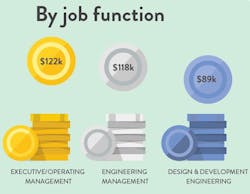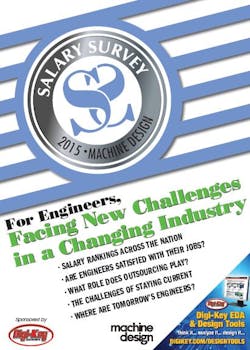2015 Engineering Compensation Survey: Facing New Challenges in a Changing Industry
The engineering field is an ever-changing environment. To better understand the world our readers live in—and to help you better understand the state of the industry—Machine Design presents its 2015 Salary Survey. More than 2,000 engineers responded to the annual survey regarding salary, work environment, benefits, and their views on where the field of engineering is going next.
How do you stack up?The Typical Engineer
According to our survey, 54.3% of our readers are 55 years old or over and predominantly male. Just over three-quarters are college graduates with a bachelor’s degree or higher. The most common principal job function is in design and developmental engineering at 61.7%, and a much smaller percentage (11.8%) work in engineering management. The most common job title is design/project/R&D engineer at 24.7%. Others include manufacturing/product engineer and chief/senior/lead/principal engineer at 6.0% and 12.9%, respectively.
The Current Workplace Environment
Our readers ranked their most pressing concerns on a scale of 1 to 10, and the majority of their concerns focus on design resources. Finding optimal components scored an average of 6.72, while insufficient funding for design projects scored an average of 6.28. Dealings with management also affect the engineering work environment, such as compromising of design approaches and the “politics” of the workplace. When asked what would cause them to consider leaving their position, 39.3% said it would be to pursue other interests—whether it was to become an independent inventor, teach, or explore a different industry.
Watch our editors discuss the results of this year’s surveys, courtesy of Engineering TV:Free time is a major factor in continuing education and 55% said that finding the balance of work and free time hinders their ability toward educational pursuits. Some ways to pursue continuing education are in the forms of engineering/technology websites, white papers, webcasts, and seminars.
How does job function affect compensation?
Staying current with new and emerging technologies is one of the main concerns engineers have, cited by 27.8% of respondents. According to one of the respondents, they “…need to benchmark to stay competitive, but innovation is what allows us to create new markets and products. We have to look outside our industry and there is an awful lot outside our industry.”
The Engineering Outlook
Outsourcing of engineering talent, while a concern, was cited by only 14.8% of respondents. The most common engineering work outsourced is design work at 49.1%, with manufacturing and assembly work coming in second at 38.1%. Most of the outsourcing work occurs within the United States, with 61.9% of the outsourced work sent to external contracting firms or engineering workhouses. China and India are the second and third most common outsource locations, at 20.6% and 15.9% respectively.
While some engineers feel that outsourcing diminishes morale and hurts efficiency, for small facilities and testing purposes, outsourcing could be an asset. For testing, it “is crucial as the capital expense for specialized equipment is prohibitive and specialized expertise speeds the process up,” said one respondent. Smaller firms “outsource work to machine shops since we don’t have the capabilities in-house beyond 3D printing.”
Perhaps most telling is that the current engineer still recommends it as a profession. An impressive 92.1% would recommend engineering to the next generation of students entering college. In addition, 69% believe salary advancement is still as promising today as it was five years ago. When asked why, many engineers believe that engineering offers solid employment and, as one respondent noted, offers “broad opportunities for advancing in technical or business management roles”.
Technical Editor Carlos M. Gonzalez wrote this report. Survey conducted and data compiled by Jay McSherry.




